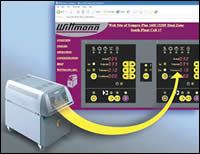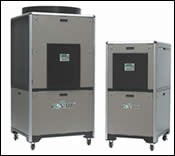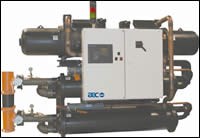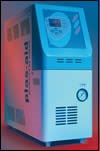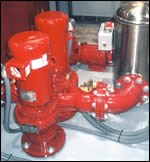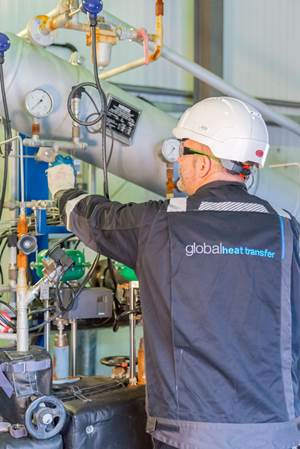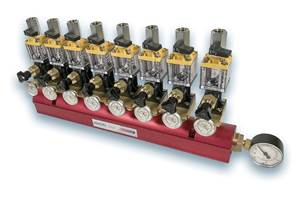NPE News Wrap-up - Water & Oil Temperature Control
If you’re the sort of manager that can’t resist checking up on your plant after you go home for the night, now you can click on your web browser and read out mold temperatures right there on your PC.
If you’re the sort of manager that can’t resist checking up on your plant after you go home for the night, now you can click on your web browser and read out mold temperatures right there on your PC. If you need such peace of mind, you can get it from “web-enabled” mold temperature control units, or TCUs, that were introduced at the big NPE show in Chicago.
Monitoring auxiliary equipment in cyberspace may strike some of you as a bit exotic, but most of the new developments in fluid temperature control at NPE were very down to earth. The news was mostly in components that are more compact, more durable, less prone to leaking or corrosion, and able to heat or cool your molds with less energy. More safety features and easier-to-use controls are also common on the new chillers, towers, pump tanks, and TCUs. In many cases, these features come at the same or lower cost than previous models.
New portable chillers
Budzar Industries upgraded its portable chillers with a PLC and touchscreen that displays complete operating conditions, diagnostics, and a troubleshooting guide when needed. The controls also feature complete communications, a run-hour meter, and remote online servicing capability. They have scroll compressors and nonferrous pumps, reservoirs, and piping. Air-cooled models run 0.75 to 20 tons, water-cooled are 3 to 20 tons.
Conair introduced the Thermolator line of portable chillers that are said to be “aggressively priced” but not stripped-down in terms of features. They have brazed-plate evaporators, scroll compressors on larger units, and reciprocating compressors on smaller ones. There is also a three-year warranty and plenty of options. Among them are two levels of control: A simple microprocessor type with LED is standard. Above that are a full-featured PLC with LCD screen and an option for a remote PLC.
In this series, PCA air-cooled models of 1.5 to 30 tons have fin-and-tube condensers. PCW water-cooled versions of 1.5 to 30 tons have tube-in-tube condensers on smaller units and brazed-plate condensers on the larger ones (shell-and-tube optional).
L-R Systems brought out a complete line of cooling products—its first—built by an unnamed U.S. supplier. The line includes portable air-cooled models of 0.25 to 30 tons and water-cooled units of 2 to 40 tons. They have centrifugal pumps (0.24 to 10 hp), scroll or reciprocating compressors, brazed-plate evaporators, nonferrous reservoirs, stainless-steel cabinets, and microprocessor controls with SPI communications protocol.
Also getting into chillers for the first time is Regloplas, which will roll out portable units of up to 80 tons at the start of 2004.
New from Thermal Care is the AccuChiller EQ series of air-cooled portable models (0.5 to 3 tons) with microprocessor control. They are said to be more compact than previous models and to have easier access for maintenance.
Wittmann’s new portable chillers have been completely redesigned since its acquisition of Capitol Temptrol last year. These air- and water-cooled models of 2 to 15 tons now have all-stainless cabinets, nonferrous plumbing, brazed-plate heat exchangers, and scroll compressors.
Central chillers evolve
AEC’s new central chillers employ rotational compressors, which are said to be more reliable and efficient than reciprocating (discus) compressors. The latter have up to twice as many moving parts, which cause more noise and vibration. The R series comprises two groups: RC models of 30 to 100 tons have scroll compressors and stainless brazed-plate evaporators. RS units of 60 to 195 tons use screw compressors (said to be more efficient) and shell-and-tube evaporators in models over 100 tons; smaller units in this group have the more compact stainless brazed-plate evaporators.
While The RC models use conventional R-22 refrigerant, RS models use newer R-134a non-CFC refrigerant, which is less ozone-depleting and also up to 12% more energy efficient, according to AEC. While smaller chillers have been using R-134a, AEC believes its RS models are the first large industrial screw-type units to use this refrigerant.
Two levels of Allen-Bradley touchscreen controls are offered for the R Series—a basic monochrome version to control up to four compressors in one or two circuits, and a more advanced color model that can also control cooling-tower fans and pumps, as well as chemical water-treatment pumps.
Sister company Sterlco introduced a similar S Series of central chillers, except that Sterlco uses PLCs from Mitsubishi instead of Allen-Bradley.
Berg Chilling Systems has a new line of large packaged chillers and pumps from 30 to 200 tons. They boast smaller footprints and easier servicing since they are built all on one level. They also have a new, simple-to-use touchscreen controller.
Budzar’s new WM (water-cooled) and AMO (outdoor air-cooled) central chillers have a PLC and touchscreen that displays complete operating conditions, diagnostics, and a troubleshooting guide. Remote diagnostics can be performed via modem. Software constantly adjusts the chiller to the operating and ambient conditions, yielding operating cost/ton lower than with other chillers, the company says. Both series range from 20 to 400 tons. The AMO Series is available in a split system or with an optional on-board pump-tank system and reservoir that greatly reduce installation costs.
L-R Systems’ new cooling line includes central chillers of 20 to 200 tons with one, two, or three zones plus air or water cooling and integral pump tank with two pumps (three optional). They can have scroll, screw, or discus compressors and brazed-plate or shell-and-tube evaporators. Outputs are 60 to 600 gpm. Microprocessor controls are standard.
Mokon, which previously specialized in smaller portable chillers, unveiled its first central models at the show. These air- and water-cooled Iceman models of 30 to 80 tons have single or multiple circuits, scroll or discus compressors, brazed-plate evaporators, and microprocessor or Allen-Bradley PLC control. Standard features are all-stainless construction and electronic hot-gas bypass—said to be more accurate than mechanical bypass.
Regloplas’s new chiller offerings, to debut the first of the year, will include central models of up to 150 tons.
Thermal Care has upgraded its TX Series of central chillers, which have screw compressors and range up to 440 tons. The firm now offers compressors of 70 to 220 hp, whereas the previous maximum was 60 hp. The upgrade permits use of one large compressor in place of two small ones to reduce both cost and machine footprint. (On the other hand, dual compressors provide redundancy and better efficiency at low loads.) Also new are electronic expansion valves, said to raise energy efficiency at reduced head pressures.
Within the past year, Thermal Care also came out with a color touchscreen PLC control for its central chillers. It displays the entire plant cooling system and the run-time hours on all equipment. You just touch an icon to bring up all the details for any piece of equipment in the system.
In addition, Thermal Care’s TS Series of central chillers up to 100 tons have a new low-cost Allen-Bradley PLC and PanelView display.
Wittmann redesigned its central chillers since its Capitol Temptrol acquisition. Models up to 300 tons can have screw, scroll, or discus compressors. In what may be a unique option, these multi-circuit systems can have a so-called “free cooling” coil packaged with the chiller. This allows the system to switch automatically from the chiller to ambient cooling whenever the outdoor temperature drops to 40 F or below.
Pump tanks
Several firms also brought out new pump tanks for central chilling systems. Mokon, for example, introduced its first line of such products, in standard sizes from 250 to 3500 gal and in stainless or carbon steel.
Thermal Care added an intermediate size—1100 gal—to its line of fiberglass/plastic pump tanks, which go up to 2200 gal. The line also has a new compact (1/16 DIN) control.
Wittmann introduced an unusual pump-tank design with four pumps for the same price as the usual three. Standard systems have one recirculation pump, one process pump, and often one backup pump that can substitute for either of the first two. Instead Wittmann’s new setup has two pairs of Armstrong dual-arm pumps—one pair for recirculation and one for the process. One member of each pair is a back-up that comes on automatically if the first one fails—or the two pumps can be used in an alternating schedule to minimize wear and extend their life. These Armstrong pumps have integral valves, which reduce cost. Also, their vertical mounting eliminates the need for bearings, so they run quieter, Wittmann says. Oversized fittings are said to provide 60% more flow than in typical systems.
Pump tanks are also part of the new cooling-system offerings from L-R Systems. They range from 250 to 5000 gal with pumps of 2 to 60 hp.
Smarter cooling towers
New controls for cooling towers and pump-tank stations were highlighted by Advantage Engineering. The new CheckMate Series is said to be less expensive and simpler to use than PLCs and can control up to 12 motors. Two versions are offered: The LE model has an LCD display, while the HE version has a touchscreen. The LE displays water temperatures to and from the process and allows you to change thermostat settings without opening the cabinet. The HE can display time/temperature graphs and the fan’s run-time hours. Options include display of water quality—pH and dissolved solids—as well as wet-bulb temperature.
CheckMate systems also have the company’s new Top Operator pump/fan control. It combines three traditional components in one module—on/off or on/off/auto switch, running light, and overload light. Top Operator can also work with any PLC system.
Marley Cooling Towers introduced two new product lines. Primus crossflow UniBasin factory-assembled towers boast a simpler design, lower cost, and faster delivery (two weeks). They have an integrated fan cylinder and distribution basin on top and a one-piece collection basin on the bottom—both of rotomolded polyethylene. Primus systems are said to be lighter and quieter than most and have no valves.
Also new are Modulus counterflow modular towers. These stainless-steel units have a simple design that reportedly allows them to be erected in one-third the time of conventional “stick-built” towers.
L-R Systems now offers cooling towers of 45 to 450 tons with nonferrous construction, structural base, and gasketed, easily removed inspection covers. They can have single or multiple cells.
Water treating/filtering
New from Miller-Leaman is the automatic Turbo-Disc water filter. This fully automatic unit is offered for both side-stream and full-flow applications. It has stainless-steel manifolds and comes with or without a booster pump. It reportedly uses a fraction of the flushing water used by traditional sand filters.
Automatic Filters now makes its Tekleen water filter in stainless steel at the same price as before.
Both AEC and Sterling have new arrangements to offer the TowerKleen chemical-free water-treatment system. AEC calls it the TK Series, and Sterling dubs it the STK Series.
L-R Systems now offers water filters with 1-psi pressure drop as well as automatic water-treatment systems, heat exchangers, and centrifugal separators.
Hot-water TCUs on the web
Wittmann claims to have introduced the industry’s first “web-enabled” TCUs. They have embedded web servers in the controls that give users access to setpoints, maintenance documents, operating instructions, and troubleshooting assistance from any location. The web servers also have interfaces to Wittmann’s Wittlink software, which allows setpoints and operating data to be communicated to and from an entire cell of Wittmann auxiliaries.
Wittmann also brought out two new TCUs. The Tempro Direct 250 is a microprocessor-controlled unit with direct-injection cooling. It comes with turbine pumps of 1 to 3 hp that are said to generate higher pressure (50 to 90 psi) and higher flow (6 to 8 gpm) than typical units with centrifugal pumps. Heating capacity is 9 or 12 kw. Mold evacuation or purging is optional. Price of the standard 1-hp, 9-kw unit starts at $2250. It measures just 10.2 in. wide x 19.5 in. long x 26.2 in. high.
Wittmann’s other new TCU is the Tempro Primus C, a more basic, inexpensive model that starts at $1395. This 0.75-hp, 9-kw unit can be supplied with either vacuum mold purge or negative-pressure capability. Temperature capability is 200 F (vs. 250 F for the Tempro Direct 250). It has microprocessor control, nonferrous wetted surfaces, and a high-pressure pump capable of 15 gpm at 55 psi. The submerged sealless pump eliminates leakage from mechanical pump seals.
Both AEC and sister company Sterlco introduced water-temperature controllers described as low-priced but amply equipped. AEC’s ECU Series and Sterlco’s SEU Series have centrifugal pumps from 0.75 to 7.5 hp, flow rates up to 100 gpm, and 9-kw Incoloy immersion heaters (12 kw optional). They also have up to 0.75-in. solenoid valves, and microprocessor control with process and setpoint LED readouts. Numerous safety features include automatic vent sequencing, independent high-temperature safety thermostats, adjustable low-level pressure switches, and 150-psi relief valves. Starting price for a 0.75-hp unit is $1395—$600 less than a high-end model. Delivery time is one week. Sources at these companies hint that another sister company, Economizer USA, will soon come out with even lower-priced TCU models.
Sterling also introduced a new 6-kw SEA hot-water TCU designed for European and Asian molders that prefer very small units that can slide under the press. They are used by transplant operations here that process silicone and other thermoset rubbers. Unlike the majority of U.S. molders, transplant and overseas processors also prefer closed-loop operation (i.e., using heat exchangers to interface with a separate cooling-tower circuit instead of direct injection of cooling water). The SEA unit has a new high-efficiency pump with no mechanical seal to be damaged by hard water. A hot-oil version for up to 300 F is also available.
More economical “value-priced” Thermolator hot-water TCUs are new from Conair. With pumps from 0.75 to 7.5 hp and heaters from 9 to 48 kw, the units start at $1550, down from $1695 for past models. In addition to a three-year warranty, they feature two-piece cast construction, silicon carbide pump seals, Incoloy heaters, to/from-process pressure gauges, and simple microprocessor controls with LED readout. (Higher level control options are available.) Direct-injection cooling is standard, though closed-circuit and isolated-circuit cooling are available, as are dual-zone models.
Budzar has redesigned its portable “mini” hot-water units with stainless-steel piping and pumps and higher-temperature (300 F), silicon-carbide seals. Direct-injection or closed-loop cooling are offered. Closed-loop models have stainless brazed-plate heat exchangers. Flow rates can be 20 to 100 gpm at 30 psi (50 psi optional).
Matsui has also upgraded its hot- water units in the new Plas-Aid GMC line that features lower prices but increased pump power, stainless-steel components, and simpler microprocessor controls. Nine models cover three temperature ranges (hot-oil models are also available). Pumps are 0.4, 0.8, and 1.3 hp. Water manifolds, ball valves with threaded couplers, and solid-state relays are standard.
Mokon’s line of Duratherm hot-water TCUs has been expanded from the former range of 0.75 to 3 hp up to 10 hp without increasing the cabinet size. Flow rates are now up to 120 gpm, and maximum heating capacity has been raised to 96 kw. Single- and dual-zone models offer temperatures up to 300 F. All have noncorrosive construction.
Mokon also brought out its first positive/negative-pressure units, which can temporarily stop leaks by pulling rather than pushing water through the mold. These Duratherm NPS units range up to 5 hp and handle temperatures to 180 F.
A small combination chiller and hot-water controller was introduced by Opti-Temp. Its “Cheater” (chiller/ heater) provides water temperatures from 30 to 190 F to machines processing under 100 lb/hr. It’s aimed at high-end applications that require very precise temperature control within ±0.2° F. This stand-alone, close-loop system does not require an outside water source.
A pressurized hot-water unit for 250 F and up was unveiled by Regloplas. Suited to large presses, model P120XL has heating capacity to 40 kw and water-cooling capacity to 125 kw, along with automatic water refill, negative-pressure “leak-stop” mode, and automatic suction to purge lines for mold changes.
In the past year, several firms brought out multi-zone hot-water TCUs aimed at CD and DVD molding. Among these were units of four or six zones from AEC and Sterlco. Another comes from Thermal Care. Its CRA Series is said to control within ±0.2 to 0.5° F.
L-R Systems now offers hot-water units of 0.75 to 7.5 hp and 6 to 48 kw for temperatures up to 250 F. They include modulating cooling valves, stainless-steel cabinets, continuous display of setpoint and to-process temperatures, and SPI communications protocol.
Oil TCUs go hotter
Budzar redesigned and upgraded its portable Silver Series hot-oil units, which now operate at up to 600 F vs. 450 F previously and provide flow rates up to 50 gpm (from 30 gpm before). Heating capacity is up to 48 kw. Other new features include welded pipe construction to eliminate leaks, an ultra-low-watt-density heater to prevent “coking,” and a reversible pump for mold evacuation/purging.
The latest hot-oil unit from Regloplas is model 300S for high-temperature engineering resins. This 6-kw unit heats up to 570 F and pumps 14.3 gpm at 73 psi. It offers a small footprint, magnetically coupled pump for zero leakage, negative-pressure leak-stop mode, and automatic suction for mold purging. Its microprocessor control provides simultaneous readout of set and actual temperatures. This is the smallest unit in a line that previously went from 12 to 36 kw.
Hot-oil units newly available from L-R Systems heat up to 500 F with 12 to 48 kw. They have centrifugal pumps of 1 to 7.5 hp, stainless-steel cabinets, low-watt-density heaters, continuous set and actual temperature display, and SPI communications protocol.
Other news in hot-oil systems includes the following:
- Burger & Brown launched the Smartflow hot-oil flowmeter for use at up to 550 F. This positive-displacement device is line-mounted to give visual indication of flow rates from 5 to 40 gpm on an analog gauge.
- Mokon’s new ClearFlo oil filtration system removes particles down to 10 microns without disrupting system operation. The companion ClearFlo Plus system filters particles down to 0.1 micron and also removes water.
- Paratherm Corp. showed its new SC “system cleaner” fluid, which removes sludge and carbon deposits. Run it through your system overnight, and no manual labor should be necessary.
An embedded web server lets you communicate with Wittmann’s newest temperature-control units in cyberspace.
Conair’s new Thermolator portable chillers offer low prices plus a three-year warranty, scroll compressors, brazed-plate evaporators, and two levels of controls.
Larger models of new central chillers from AEC and Sterlco use highly efficient screw compressors. These are said to be the first large chillers of this type to use more ozone-friendly R-134a refrigerant.
Matsui’s new Plas-Aid GMC hot-water and oil units offer more features and greater pump power at lower cost.
New pump-tank design from Wittmann uses two pairs of “Siamese-twin” vertical pumps to provide instant backup of recirculation or process pumps with no need for manual adjustment.
Related Content
Conair Names New Head of Customer Care
Jared Helfrich to direct the efforts of the machine builder’s growing customer care group, combining its existing parts and service and repair organization with a new range of fast-growing customer services.
Read MoreFollow These Best Practices When Working With Heat Transfer Fluids
Effectively choosing, operating and maintaining thermal fluid can positively impact productivity in plastics processing.
Read MoreIs Your Water System Setup Helping or Hurting Your Molding Plant Productivity?
The plant water system is a critical component of an injection molding facility. A poorly designed or maintained water-cooling system can have a serious impact on production efficiency and cause many maintenance issues. Here’s what you need to know — and ask — to prevent those problems.
Read MorePiovanGroup Rebrands, with Mostly Minor Name Changes
For the most part, subsidiary company names will remain, with slight modifications meant to enhance the Group’s identity.
Read MoreRead Next
Lead the Conversation, Change the Conversation
Coverage of single-use plastics can be both misleading and demoralizing. Here are 10 tips for changing the perception of the plastics industry at your company and in your community.
Read MoreMaking the Circular Economy a Reality
Driven by brand owner demands and new worldwide legislation, the entire supply chain is working toward the shift to circularity, with some evidence the circular economy has already begun.
Read MoreSee Recyclers Close the Loop on Trade Show Production Scrap at NPE2024
A collaboration between show organizer PLASTICS, recycler CPR and size reduction experts WEIMA and Conair recovered and recycled all production scrap at NPE2024.
Read More




